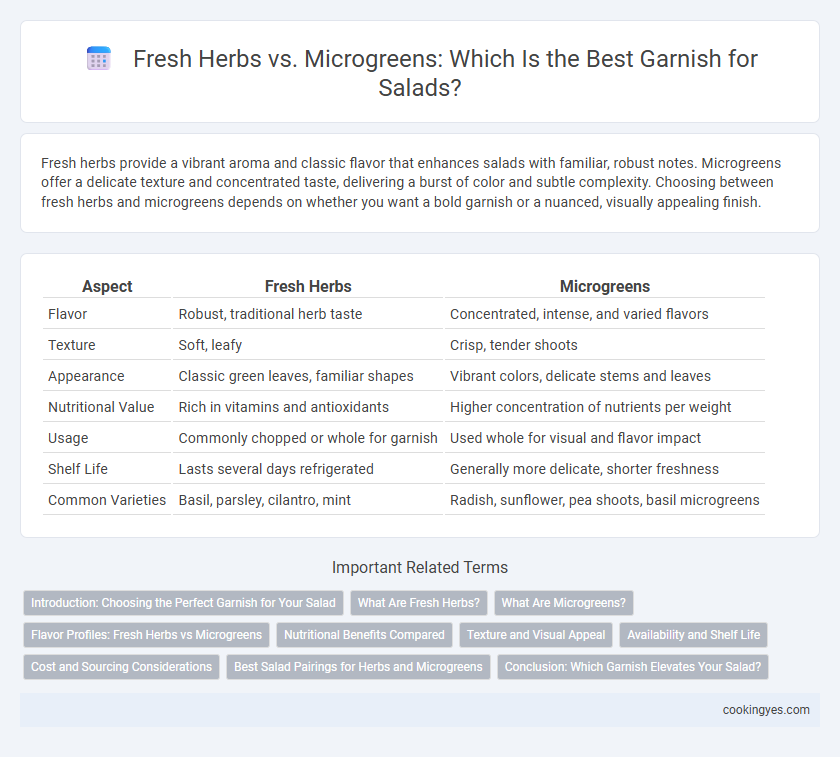Fresh herbs provide a vibrant aroma and classic flavor that enhances salads with familiar, robust notes. Microgreens offer a delicate texture and concentrated taste, delivering a burst of color and subtle complexity. Choosing between fresh herbs and microgreens depends on whether you want a bold garnish or a nuanced, visually appealing finish.
Table of Comparison
| Aspect | Fresh Herbs | Microgreens |
|---|---|---|
| Flavor | Robust, traditional herb taste | Concentrated, intense, and varied flavors |
| Texture | Soft, leafy | Crisp, tender shoots |
| Appearance | Classic green leaves, familiar shapes | Vibrant colors, delicate stems and leaves |
| Nutritional Value | Rich in vitamins and antioxidants | Higher concentration of nutrients per weight |
| Usage | Commonly chopped or whole for garnish | Used whole for visual and flavor impact |
| Shelf Life | Lasts several days refrigerated | Generally more delicate, shorter freshness |
| Common Varieties | Basil, parsley, cilantro, mint | Radish, sunflower, pea shoots, basil microgreens |
Introduction: Choosing the Perfect Garnish for Your Salad
Fresh herbs like basil, parsley, and cilantro provide bold, aromatic flavors and vibrant colors that enhance salad presentation and taste. Microgreens, such as radish, pea shoots, and sunflower, offer delicate textures and concentrated nutrients, adding a subtle yet visually appealing touch. Selecting between fresh herbs and microgreens depends on desired flavor intensity and nutritional boost for the perfect salad garnish.
What Are Fresh Herbs?
Fresh herbs are leafy green plants like basil, parsley, cilantro, and mint, commonly used to enhance the flavor and aroma of salads. They are typically harvested from mature plants, offering a robust and well-developed taste profile that complements various dressings and ingredients. Unlike microgreens, fresh herbs provide a larger volume and a more traditional herbaceous note, making them a classic choice for garnishing salads.
What Are Microgreens?
Microgreens are young vegetable greens harvested shortly after the first true leaves develop, packed with concentrated flavors and nutrients compared to mature herbs. They offer vibrant colors and delicate textures that enhance salad presentation and taste. Unlike fresh herbs, microgreens provide a more intense burst of flavor and a nutrient density rich in vitamins C, E, and K, making them an excellent garnish choice.
Flavor Profiles: Fresh Herbs vs Microgreens
Fresh herbs such as basil, parsley, and cilantro offer a robust and familiar flavor profile that can enhance salads with vibrant, aromatic notes. Microgreens, including radish, sunflower, and pea shoots, provide a concentrated burst of flavor that is often more intense and slightly peppery or tangy compared to mature herbs. The choice between fresh herbs and microgreens for garnish depends on the desired intensity and complexity of flavor in a salad.
Nutritional Benefits Compared
Fresh herbs like basil, parsley, and cilantro are rich in vitamins A, C, and K, offering potent antioxidants and anti-inflammatory properties that support overall health. Microgreens, such as radish, arugula, and sunflower microgreens, contain concentrated levels of nutrients including vitamins C, E, and beta-carotene, often providing higher antioxidant content per gram compared to mature herbs. Microgreens also supply significant amounts of minerals like potassium and zinc, enhancing their value as nutrient-dense garnishes for salads.
Texture and Visual Appeal
Fresh herbs offer a tender, leafy texture with vibrant green hues that enhance salad freshness, while microgreens provide a delicate crunch and a concentrated burst of color, often featuring reds and purples. The fine, intricate shapes of microgreens create a sophisticated visual appeal that contrasts with the broader, softer leaves of herbs like basil, cilantro, or parsley. Both options elevate salads by adding nuanced texture and a dynamic palette, but microgreens deliver a more modern, gourmet presentation.
Availability and Shelf Life
Fresh herbs like parsley and cilantro are widely available in most grocery stores and typically have a shelf life of about 5 to 7 days when stored properly. Microgreens, including varieties such as radish and arugula, are often sourced from specialty markets or grown at home, offering a shorter shelf life of around 3 to 5 days due to their delicate nature. Choosing between fresh herbs and microgreens for garnish involves balancing availability with the need for freshness to enhance salad presentation and flavor.
Cost and Sourcing Considerations
Fresh herbs typically cost less and are more widely available at local markets or grocery stores, making them a budget-friendly option for salad garnish. Microgreens, while often pricier due to specialized growing conditions and limited suppliers, offer a concentrated flavor and nutrient boost that can justify the higher cost. Sourcing fresh herbs can be straightforward with home gardening or bulk purchasing, whereas microgreens often require sourcing from specialty growers or urban farms to ensure freshness and quality.
Best Salad Pairings for Herbs and Microgreens
Fresh herbs like basil, cilantro, and dill add vibrant flavors and enhance salads such as Caprese, Greek, and cucumber-tomato combinations, while microgreens like radish, pea shoots, and sunflower provide a crunchy texture and mild peppery notes ideal for mixed green and grain salads. Each herb pairs best according to its native cuisine, with mint complementing Middle Eastern salads and parsley adding freshness to Mediterranean dishes, whereas microgreens offer versatility in both flavor and presentation. Choosing between fresh herbs and microgreens depends on the desired texture and intensity, with herbs providing aromatic depth and microgreens delivering a subtle, crisp finish.
Conclusion: Which Garnish Elevates Your Salad?
Fresh herbs deliver robust, aromatic flavors that complement a wide variety of salad greens, enhancing both taste and visual appeal. Microgreens offer a vibrant, nutrient-dense option with delicate textures and intense colors, providing a modern, health-focused garnish. Choosing between fresh herbs and microgreens depends on the desired flavor intensity and presentation, but microgreens often elevate salads with their striking appearance and concentrated nutrients.
Fresh Herbs vs Microgreens for garnish Infographic

 cookingyes.com
cookingyes.com